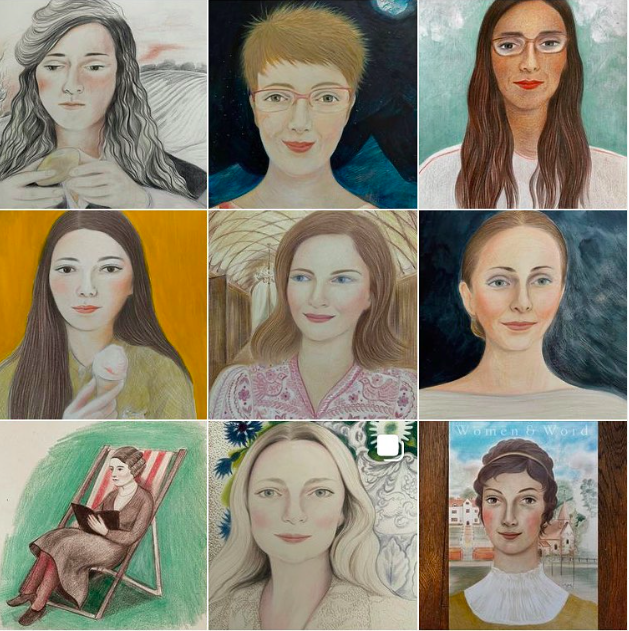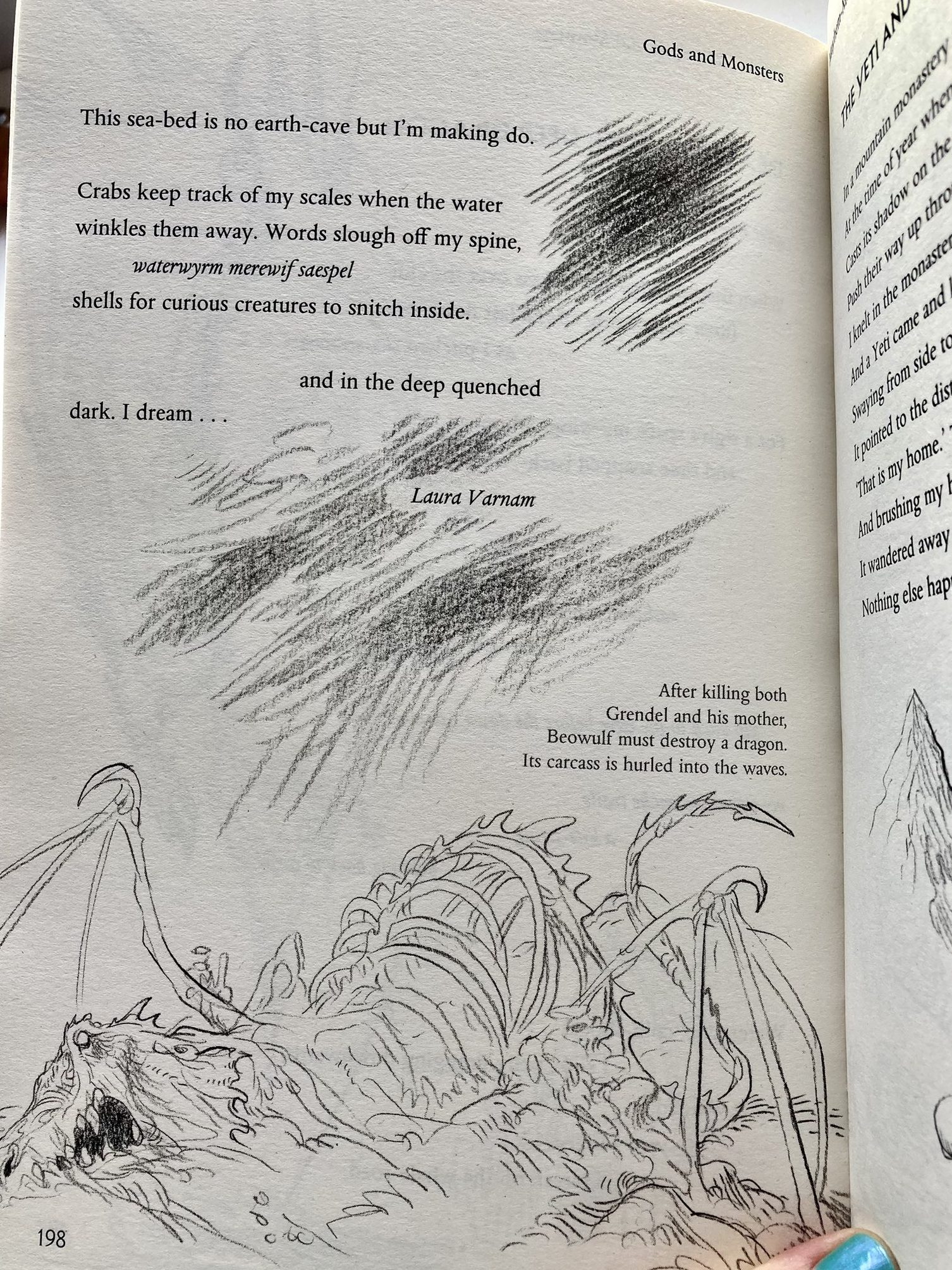Hello everyone! It’s been a while since I updated my blog and lots of exciting things have been happening, both on the poetry and research front!
In September, the fantastic anthology Gods & Monsters: Mythological Poems was published, edited by the brilliant Ana Sampson and illustrated by the incredible Chris Riddell. I was absolutely over the moon to contribute my poem ‘Dead Dragon, Deep Dragon’ to this anthology. The poem was first published in Acropolis Journal last year and it’s my response to the very unceremonious way in which the dead body of the dragon is disposed of at the end of Beowulf. Both the hero and dragon are dead but where Beowulf is sent on his way with a funeral pyre and plenty of ritualised mourning, the dragon’s body is kicked off the cliff into the sea. I wanted to suggest in my poem that despite this cruel treatment, the dragon has an afterlife in the deep and in our imaginations.
I was thrilled with Chris Riddell’s illustrations, they’re so evocative. The entire book is a marvel and I’d really recommend it! Enormous thanks to Ana for inviting me to contribute!
***
In September I gave a reading from my Beowulf poetry project at the TOEBI conference in Birmingham (Teachers of Old English in Britain and Ireland). Many thanks to Megan Cavell and Linda Brady for having me! It was a really inspiring and exciting event and lovely to connect with so many colleagues from across the country, all of whom are involved in teaching and researching Old English. I read a selection from my Grendel’s Mother poems and I was really grateful for the questions that I was asked about my practice in the poems, particularly in terms of the use of Old English. (In my dragon poem above I leave three Old English words to speak for themselves and I hope that the inclusion of the original language will be inviting and engaging for general readers who might want to learn more!)

***
This month I had a rather experimental piece of creative non-fiction published over at Annie Journal. I’m so grateful to Charley Barnes and Wendy Allen for choosing my ‘personal essay plus poem’ combo for the second issue of Annie. My piece is called ‘In the Gæsthus with Beowulf‘ and the essay is about my first, rather difficult, encounter with Old English as an undergraduate student. (It also debuts my latest translation of the open ‘hwæt’ as ‘welcome’, which I’m rather excited by!)

The essay is written around a poem that explores the fact that my relationship with Beowulf hasn’t always been easy or without its challenges. Pop over to this link to read the piece. (The title is a pun on the familiar and much-loved poetic compound in Old English, the ‘banhus’ or ‘bone-house’ for the body. I imagine Beowulf as a ‘gæsthus’, playing with the meanings of gæst as guest/enemy/stranger/ghost. In my poem, I wonder whether I’ve been consumed by Beowulf– like Jonah inside the whale!- Am I a guest or a ghost in its pages? Have I been haunted by its monsters and is there any way to break free? I suspect the answer to that is no, it’s too late!!)
***
In other news, I was delighted to be asked by my former college, Lady Margaret Hall, to review Nancy Campbell‘s award-winning memoir Thunderstone for the Brown Book (the LMH alumni book). I’m going to repost my review on my blog in the coming days and I urge you to pick up the book if you haven’t already read it! Nancy is the most marvellous writer and Thunderstone meant a great deal to me when I first read it in the summer of 2022.
It’s been so lovely to be invited to reflect upon the talents of other writers and artists recently, none more so than the work of Daisy Harcourt whose exhibition of portraits, Women & Word, is open this month at Weald Contemporary gallery. Daisy was a student at Univ and I was thrilled when she asked me if she could draw my portrait as part of the exhibition! Daisy asked all of the contemporary women who were involved in the project to send her a short piece of writing about their relationship with words, highlighting any particular words that resonated with them, and she used these meditations while creating her portraits, which I think is a wonderful idea.
I was so thrilled with my portrait (top row, middle below!) and I was even more excited when Daisy asked me to write the introduction to the exhibition catalogue. It was a real pleasure to read the words of all the other contemporary women writers involved and to reflect on Daisy’s wonderful portraits.

***
My final update for now is about my work on Margery Kempe! I was thrilled to be invited to give a talk at King’s Lynn Minster in September as part of the celebrations of Margery Kempe’s 650th anniversary. In Margery’s day, the Minster was her parish church of St Margaret’s and my first major piece of scholarship on her Book was a discussion of the importance of the church in Margery’s life and narrative and her representation as an exemplary parishioner (you can read my article in Nottingham Medieval Studies here). It was a huge honour and a great pleasure to go back to Lynn- the first time since my graduate student days!- and it was lovely to see the new commemorative bench outside the church (see below!) and to see the increased presence of Margery within the church itself, thanks to the work of the rector, Mark Dimond, and his team, the sculptor Rosemary Goodenough, and also the contributions of our Margery Kempe Society secretary Luke Penkett.
In my talk I explored the presentation of Margery Kempe as a woman writer in modern adaptations of her Book, including Mary Sharratt’s novel Revelations and Victoria MacKenzie’s For thy great pain have mercy on my little pain (and you can check out my interview with Victoria about her novel on the Margery Kempe Society website). This talk will form part of my current book project on Margery Kempe and medievalism, so I really appreciated the engaged questions from the audience!
(I was pretty excited to be back at St Margaret’s, as you can tell!)
I’ll be talking about my current and past research on Margery next month on her feast day in the Church of England, 9th November, at Wycliffe Hall in Oxford, so I’m looking forward to that!
Thanks for reading and best wishes to all!






